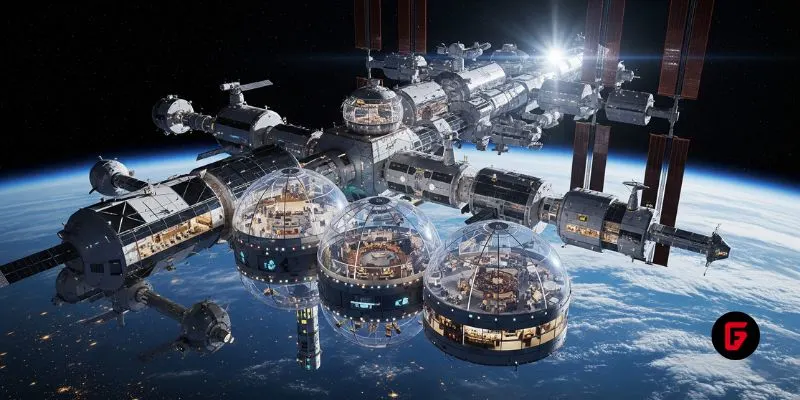NASA is taking a bold new approach to maintaining America’s presence in low Earth orbit, announcing a major shift in how it partners with private companies to build the next generation of space stations. As the International Space Station (ISS) approaches its planned retirement in 2030, the agency’s latest strategy pivots toward flexibility, cost management, and realistic operational expectations—and it’s sending shockwaves through the space industry.
Why is NASA Changing Its Approach to Commercial Space Stations?
NASA had originally set a course to maintain a continuous, ISS-style human presence in orbit and award lucrative, competitive contracts to a handful of station constructors. However, a combination of budget shortfalls and the daunting complexity of replacing the ISS prompted a reality check at the highest levels.
In a directive signed in late July 2025, NASA’s leadership abandoned its prior plan to select fixed-price contract winners by 2026. Instead, the agency will now support a wider range of companies through funded Space Act Agreements—less rigid contracts that allow NASA to adapt support as funding and schedules shift. This method avoids deep financial commitments until the technical and business environments are more predictable and mature.
This strategic change goes deeper than just financial flexibility. NASA no longer requires that its replacement stations support a permanent human presence like the ISS. Now, the minimum baseline is the ability to host four-person crews for about a month—a significant reduction from the round-the-clock, six-month shifts that have defined U.S. activity in space for decades.
What Does This Mean for Companies Competing to Build New Space Stations?
The new plan reshuffles the competitive deck for the companies aspiring to serve as America’s outpost in orbit. For newcomers like Vast, whose Haven-1 station is set for a possible May 2026 launch, these lower requirements are a perfect fit. Haven-1 is designed to support four astronauts for short, 10-to-30 day missions—a pragmatic demonstration of what NASA now calls its “minimum viable product” for space habitats. CEO Max Haot recently confirmed manufacturing is on track and the company’s target is to become the first private space station in orbit.
Meanwhile, ambitious stations like Blue Origin’s Orbital Reef and Starlab, both backed by NASA under Space Act Agreements, now face new headaches. Orbital Reef, envisioned as a sprawling commercial complex with room for up to ten, has struggled with delays and updates; progress has recently been limited to major human-in-the-loop test milestones. Starlab, while progressing with preliminary milestones, now faces the tough reality that its long-duration, high-capacity vision might not align with NASA’s pared-down funding or operational needs.
Axiom Space—originally planning a modular approach, attaching to the ISS before flying free—is also adjusting timelines, reflecting industry-wide momentum swings as everyone races the ISS retirement clock.
How Will NASA’s Flexible Partnerships Shape the Future of Low Earth Orbit?
NASA’s adoption of Space Act Agreements over traditional contracts signals a radical shift in how America will “outsource” its orbital ambitions. Instead of just picking favorites, NASA will nurture multiple contenders, providing funding, technical help, and credibility but leaving the heavy investment and risk to private industry. The hope: this competitive flexibility will speed up development, drive costs down, and allow for quicker adaptation if technical or financial shocks arise.
Yet, the flip side is uncertainty. None of the contenders is on track to match the full capabilities of the ISS at launch, and there is a real risk of a gap in human presence in low Earth orbit—a stark contrast to the continuous U.S. occupation since 2000.
What Are the Biggest Risks and Opportunities in NASA’s New Game Plan?
This bold, pragmatic pivot has winners and losers:
Winners: Smaller, agile entrants like Vast, which can rapidly deliver short-duration missions. These stations now have a real shot at “proof-of-concept” flights that might open new scientific, manufacturing, and tourism markets.
On the fence: Ambitious, ISS-sized projects (Orbital Reef, Starlab) must show they can deliver incrementally and align with NASA’s evolving requirements or risk falling behind.
Losers: Any ventures betting on the old model of guaranteed, ISS-level, multi-year funding for monumental infrastructure now face much higher uncertainty and must seek private investment or alternate business cases.
Meanwhile, NASA’s pivot is inevitably colored by political tensions—balancing the need to avoid leadership vacuums in low Earth orbit as China’s Tiangong station sets a rival standard, and needing bipartisan buy-in amid leadership churn at the agency’s top ranks.
As the ISS counts down its final years, the next chapter in commercial space station history is unfolding with more hustle, less certainty, and a keen focus on flexibility—a test of American ingenuity in the toughest business environment there is: outer space.














